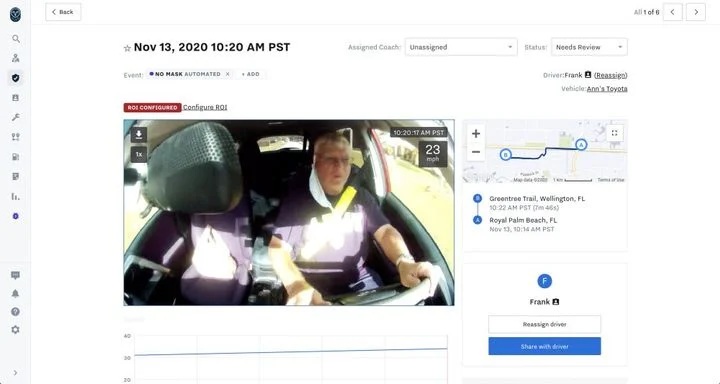Photo: Samsara
Using advanced artificial intelligence, dual-facing Samsara AI Dash Cams can now automatically detect if a driver is not wearing a mask.
Roughly nine months into the COVID-19 pandemic, many fleets are adapting to a fully remote work environment—finding new ways to communicate with employees, as well as train recently hired drivers without in-person interaction. But this represents a challenge for safety managers who historically relied on in-person training and coaching. Those challenges are only made worse by the driver shortage. In a recent Samsara survey, 32% of fleet customers said attracting and retaining drivers is the top challenge their business is facing this year.
Because of these trends, Samsara is announcing three new Samsara AI Dash Cam features to help fleets navigate the challenges associated with remotely coaching, training, and engaging drivers:
- Mask Detection: Using advanced artificial intelligence, dual-facing Samsara AI Dash Cams can now automatically detect if a driver is not wearing a mask.
- Live Streaming: Safety managers have the option to perform virtual ride-alongs by accessing live video of vehicles on the road.
- Driver Video Share: Safety managers can share event videos directly with drivers, enabling remote and self-guided coaching.
Promoting Consistent Mask-Wearing by Drivers
Because commercial drivers are essential workers, the CDC has provided specific guidance for their safety—which includes wearing a mask in public settings, such as when pumping fuel, going into a truck stop or gas station, picking up food, and completing a pickup or delivery. For most truck drivers, their COVID-19 exposure risk is low when they are alone in their cab, Samsara noted. But for drivers who work in pairs or transport other people (like ambulance or bus drivers), a mask may be required all the time.
Given these guidelines, many fleets now require drivers to wear masks while on the job. But without being in the field, it can be difficult for safety managers to promote consistent mask-wearing, ensure driver safety, and avoid possible fines.

Safety managers can share event videos directly with drivers, enabling remote and self-guided coaching. Photo: Samsara
Samsara’s new AI-based Mask Detection feature can automatically detect if a driver is not wearing a mask. With optional in-cab alerts for drivers and auto-uploaded footage for safety managers, Mask Detection makes it possible to remotely coach drivers on the importance of mask-wearing.
Virtual Ride-Alongs
Many fleets are adjusting their driver training and coaching processes to limit COVID-19 exposure. Previously, safety managers or tenured drivers would often join new drivers for their first few shifts to provide feedback and support. These ride-alongs are a great way to provide real-time training for new drivers—but they are time-consuming, hard to do at scale, and difficult to do safely during COVID-19.
Samsara’s new Live Streaming feature enables virtual ride-alongs, making it possible to safely onboard new drivers in an increasingly remote workplace. Now, safety managers can stream road-facing video, inward-facing video, or both from Samsara AI Dash Cams to their Samsara dashboard, in real time.
Samsara has also incorporated driver-centric features for privacy. In-cab alerts notify drivers any time a live stream starts and ends to ensure drivers always know when Live Streaming is activated.
Remote Coaching
With many teams working remotely for the first time, the pandemic has posed new challenges for employee communication. With Driver Video Share, safety managers can share event videos directly with drivers, who will receive a text notification with a link to the event details and video. This enables evidence-based, self-guided coaching that can happen on a mobile device and at a driver’s own pace, since they can access the videos whenever it’s convenient. Even after the COVID-19 pandemic is over, this feature will allow drivers to receive one-on-one coaching and feedback without needing to go back into the office.
by WT Staff
Source: https://www.automotive-fleet.com
CUT COTS OF THE FLEET WITH OUR AUDIT PROGRAM
The audit is a key tool to know the overall status and provide the analysis, the assessment, the advice, the suggestions and the actions to take in order to cut costs and increase the efficiency and efficacy of the fleet. We propose the following fleet management audit.




